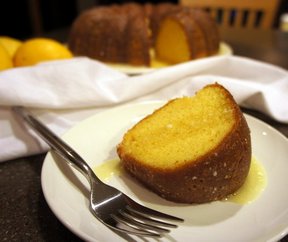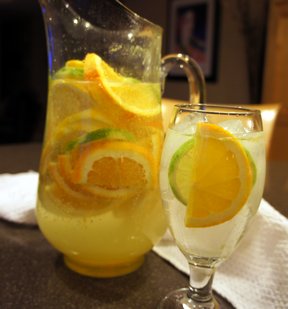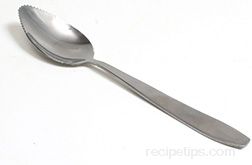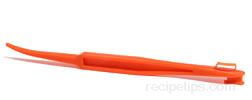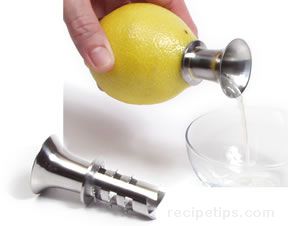Similar Content to: Citrus or Grapefruit Spoon
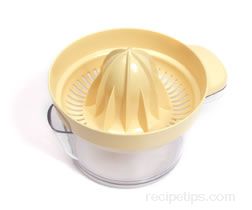
The simplest Juicers consist of Juicer Reamers made of wood or metal that have cone-shaped heads with gear-like protrusions built to be pressed against the meat of a fruit half in order to extract the juice. There are several different shapes to the head that are produced ranging from stout and round to narrow and more pointed. Each serves to accomplish the task of breaking apart the flesh and providing juice. Other varieties of hand-held utensils include Juicing Squeezers or Presses, Juicing Funnels, or Bowl Juicers. The Juicer Squeezers which function as a juice press, use a procedure to either press against the flesh of half the fruit to extract the juice or press against the rind to turn the rind and flesh inside out for extracting. Juicing Funnels or Trumpets as they are also known, are inserted into the whole fruit and then a gentle squeeze on the fruit is required to begin the flow of the juice.
The manual Juicers known as hand juicing presses, are typically built with a solid ribbed cone or cup that presses down on half of an orange, lime, lemon, tomato or other similar food to extract the juice. Some larger manually operated Juicers revolve the fruit or vegetable as the pulp is crushed while the liquid flows to a bowl or holding platter below. In addition to the small manual Juicers there is a larger vertical juicing press that has a holding container midway up the main structure of this device into which the fruit is placed. A hand lever mechanism with a cone shaped "hat-like" press or a flat surfaced press is positioned at the top of this utensil. The lever is pulled down so the press meets the fruit in the container, crushing it to extract the juice so it falls into a glass or some type of container below. Hand or manual Juicers may also be made that look like a potato ricer with a holding container into which the half of a fruit or a whole tomato is placed and then a top plate attached to a lever is pressed down into the container that has a companion lever so the two levers are brought together as the fruit is squeezed and the juice flows out small holes around the bottom and sides of the container.
There are a wide variety of automatic Juicers, also known as Juicing Machines, with numerous features to consider. Typically, automatic juice extractors are categorized into centrifugal juicers or masticating juicers. The centrifugal juicers are built of stainless steel or plastic with round containers placed over a rotating motor that drives the rotating blade. Molded into the circular shape is a food chute that may be crescent or rectangular shaped. The typical horsepower (HP) will range from 1/4 to 3/4 HP, providing from 3,600 to over 20,000 revolutions per minute (RPM's). The higher RPM's of the centrifugal Juicers causes more heat and more oxidation (foaming action) to the food being crushed, which decreases the nutrients in the food. Some models allow for continuous juicing so fruit and vegetables can be continually added to the machine without shutting down to remove pulp from holding compartments or containers. The Juicer produces good quality juice, which is often pulp free. It also produces a good yield from the item being crushed.
Masticating Juicers, which operate at fewer revolutions per minute than centrifugal Juicers, generally have from 1/4 to 1/3 horsepower with an RPM rating of 80 to 2,000 RPM's. They are constructed of stainless steel or plastic with a motor shaft extending out horizontally from the machine. Attached to the motor shaft is a single or dual gear auger mechanism that rotates slowly as it crushes the fruit or vegetable. A vertical food chute extends upward from the auger, which is circular in shape. As the food is pushed through the chute, the slower crushing action of a masticating Juicer provides a more effective crushing action than a centrifugal juicer, creating less heat resulting in less damage to the food being crushed. It also is superior in providing more juice, retaining more nutrients, from a wider variety of foods that can be crushed, such as fruits, whole vegetables, vegetable greens, or wheat grass. Masticating Juicers, which are considered to be more functional as multipurpose machines, can often be used to grate, homogenize, mince, chop, and extrude foods. They may be able to be used to function as a blender, food processor or food mill to make nut butters, baby food, frozen desserts, or mince and chop various meats and other foods. Depending on the model selected, the masticating juicer may also be able to extrude pasta.
One of key differences in Juicers is the manner in which the pulp is crushed and either retained or removed from the juice, depending on the process used for juicing. Some automatic Juicers remove the pulp, placing it in a holding container to be thrown away while others allow the pulp to flow into a retaining basket to be used as part of the juice, thus providing a greater volume of juice. If pulp is not desired, look for Juicers that automatically eject the pulp.
Some of the key considerations to ponder when selecting an automatic Juicer are the purpose of use, the construction desired, the ease of cleanup, ease of disassembly and reassembly, the quality and yield of the juice, the pulp extraction, the continuous juicing feature, the multi-purpose capabilities, and the warranty if this applies to the product purchased.
Juicers which may also be referred to as Juice Extractors are made as small a





